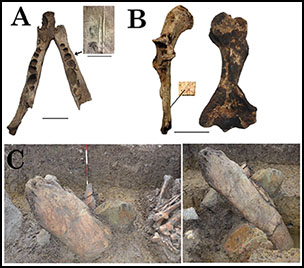Crossref Citations
This article has been cited by the following publications. This list is generated based on data provided by
Crossref.
McFadden, Clare
Buckley, Hallie
Halcrow, Siân E.
and
Oxenham, Marc F.
2018.
Detection of temporospatially localized growth in ancient Southeast Asia using human skeletal remains.
Journal of Archaeological Science,
Vol. 98,
Issue. ,
p.
93.
Jones, Rebecca K.
Piper, Philip J.
Groves, Colin P.
Nguyễn Anh, Tuấn
Nguyễn Thi, Mai Huong
Nguyễn Thị, Hảo
Hiep Hoang, Trinh
and
Oxenham, Marc F.
2019.
Shifting subsistence patterns from the Terminal Pleistocene to Late Holocene: A regional Southeast Asian analysis.
Quaternary International,
Vol. 529,
Issue. ,
p.
47.
Deng, Zhenhua
Hung, Hsiao-chun
Li, Zhen
Carson, Mike T.
Huang, Qiang
Huang, Yunzhong
and
Lu, Houyuan
2019.
Food and ritual resources in hunter-gatherer societies: Canarium nuts in southern China and beyond.
Antiquity,
Vol. 93,
Issue. 372,
p.
1460.
McFadden, Clare
and
Oxenham, Marc F.
2019.
The Paleodemographic Measure of Maternal Mortality and a Multifaceted Approach to Maternal Health.
Current Anthropology,
Vol. 60,
Issue. 1,
p.
141.
Scott, Rachel M.
Buckley, Hallie R.
Domett, Kate
Tromp, Monica
Trinh, Hiep Hoang
Willis, Anna
Matsumura, Hirofumi
Oxenham, Marc F.
and
Cray, JJ
2019.
Domestication and large animal interactions: Skeletal trauma in northern Vietnam during the hunter-gatherer Da But period.
PLOS ONE,
Vol. 14,
Issue. 9,
p.
e0218777.
Matsumura, Hirofumi
Hung, Hsiao-chun
Higham, Charles
Zhang, Chi
Yamagata, Mariko
Nguyen, Lan Cuong
Li, Zhen
Fan, Xue-chun
Simanjuntak, Truman
Oktaviana, Adhi Agus
He, Jia-ning
Chen, Chung-yu
Pan, Chien-kuo
He, Gang
Sun, Guo-ping
Huang, Wei-jin
Li, Xin-wei
Wei, Xing-tao
Domett, Kate
Halcrow, Siân
Nguyen, Kim Dung
Trinh, Hoang Hiep
Bui, Chi Hoang
Nguyen, Khanh Trung Kien
and
Reinecke, Andreas
2019.
Craniometrics Reveal “Two Layers” of Prehistoric Human Dispersal in Eastern Eurasia.
Scientific Reports,
Vol. 9,
Issue. 1,
Jones, Rebecca K.
Piper, Philip J.
Wood, Rachel
Nguyen, Anh Tuan
and
Oxenham, Marc F.
2019.
The Neolithic transition in Vietnam: Assessing evidence for early pig management and domesticated dog.
Journal of Archaeological Science: Reports,
Vol. 28,
Issue. ,
p.
102042.
Cares Henriquez, Alejandra
and
Oxenham, Marc F.
2020.
A new comprehensive quantitative approach for the objective identification and analysis of linear enamel hypoplasia (LEH) in worn archaeological dental assemblages.
Journal of Archaeological Science,
Vol. 113,
Issue. ,
p.
105064.
Lam, Thi My Dzung
Nguyen, Thi Thuy
Tran, Thi Kim Quy
Bellwood, Peter
Higham, Charles
Petchey, Fiona
Grono, Elle
Nguyen, Chieu
and
Piper, Philip J.
2020.
Ru Diep and the Quynh Van culture of central Vietnam.
Archaeological Research in Asia,
Vol. 22,
Issue. ,
p.
100190.
Conrad, Cyler
Franz, Eden
Green, Ernestene
and
Jones, Emily Lena
2020.
New radiocarbon dates from prehistoric Non Nok Tha, Don Kok Pho and Don Pa Daeng, upper Nam Phong watershed, Khon Kaen Province, Northeast Thailand.
Archaeological Research in Asia,
Vol. 24,
Issue. ,
p.
100233.
Amano, Noel
Wang, Yiming V.
Boivin, Nicole
and
Roberts, Patrick
2021.
‘Emptying Forests?’ Conservation Implications of Past Human–Primate Interactions.
Trends in Ecology & Evolution,
Vol. 36,
Issue. 4,
p.
345.
Oxenham, Marc F
Hiep, Trinh Hoang
Matsumura, Hirofumi
Domett, Kate
Huffer, Damien
Crozier, Rebecca
Nguyen, Lan Cuong
and
McFadden, Clare
2021.
Identity and community structure in Neolithic Man Bac, northern Vietnam.
Archaeological Research in Asia,
Vol. 26,
Issue. ,
p.
100282.
Higham, Charles F.W.
2021.
The later prehistory of Southeast Asia and southern China: the impact of exchange, farming and metallurgy.
Asian Archaeology,
Vol. 4,
Issue. 2,
p.
63.
Zhu, Simei
Li, Fajun
Chen, Xianglong
Fu, Xianguo
and
Hu, Yaowu
2021.
Subsistence and health in Middle Neolithic (9000–7000 BP) southern China: new evidence from the Dingsishan site.
Antiquity,
Vol. 95,
Issue. 379,
p.
13.
Vlok, Melandri
Buckley, Hallie R.
Miszkiewicz, Justyna J.
Walker, Meg M.
Domett, Kate
Willis, Anna
Trinh, Hiep H.
Minh, Tran T.
Nguyen, Mai Huong T.
Nguyen, Lan Cuong
Matsumura, Hirofumi
Wang, Tianyi
Nghia, Huu T.
and
Oxenham, Marc F.
2021.
Forager and farmer evolutionary adaptations to malaria evidenced by 7000 years of thalassemia in Southeast Asia.
Scientific Reports,
Vol. 11,
Issue. 1,
Bentley, R. Alexander
Pradier, Baptiste
Kyaw, Aung Aung
and
Pryce, T.O.
2021.
Kinship and migration in prehistoric mainland Southeast Asia: An overview of isotopic evidence.
Archaeological Research in Asia,
Vol. 25,
Issue. ,
p.
100260.
Kahlert, Thorsten
O'Donnell, Shawn
Stimpson, Christopher
Mai Hương, Nguyễn Thị
Hill, Evan
Utting, Benjamin
and
Rabett, Ryan
2021.
Mid-Holocene coastline reconstruction from geomorphological sea level indicators in the Tràng An World Heritage Site, Northern Vietnam.
Quaternary Science Reviews,
Vol. 263,
Issue. ,
p.
107001.
Dai, Jinqi
Cai, Xipeng
Jin, Jianhui
Ge, Wei
Huang, Yunming
Wu, Wei
Xia, Taoqin
Li, Fusheng
and
Zuo, Xinxin
2021.
Earliest arrival of millet in the South China coast dating back to 5,500 years ago.
Journal of Archaeological Science,
Vol. 129,
Issue. ,
p.
105356.
Vlok, Melandri
Buckley, Hallie R.
Domett, Kate
Willis, Anna
Tromp, Monica
Trinh, Hiep H.
Minh, Tran T.
Mai Huong, Nguyen T.
Nguyen, Lan Cuong
Matsumura, Hirofumi
Huu, Nghia T.
and
Oxenham, Marc F.
2022.
Hydatid disease (Echinococcosis granulosis) diagnosis from skeletal osteolytic lesions in an early seventh‐millennium BP forager community from preagricultural northern Vietnam.
American Journal of Biological Anthropology,
Vol. 177,
Issue. 1,
p.
100.
Zhang, Xi
Huang, Chao
Zhou, Zhenyu
Olsen, John W.
Huang, Qiang
and
Guan, Ying
2022.
Plant Consumption by Early-Middle Neolithic Peoples in Guangxi, South China: Archaeobotanical Evidence From the Dingsishan Site.
Frontiers in Earth Science,
Vol. 10,
Issue. ,





